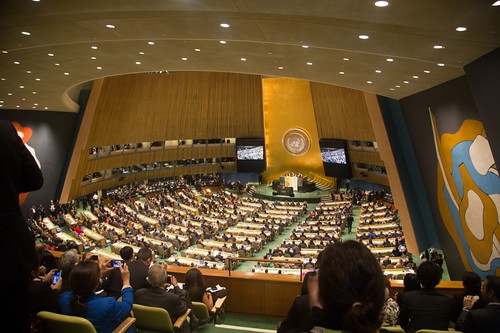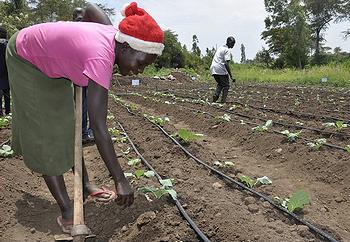金融、農業、林業、能源、產業、調適、交通層面 關鍵承諾全紀錄
在紐約舉辦的聯合國氣候高峰會,23日由政府、企業、金融、民間之各方代表來共同發表宣言,要以新的行動來即刻解決氣候變遷之問題。
金融,農業,林業匯集的城市、企業和公民的新舉措,以及新聯盟將針對溫室氣體排放做削減,並增強對於氣候變化和全球變暖影響之適應、抵抗力。
聯合國秘書長潘基文表示,改變已經開始,在今天,氣候高峰會已展現了一個全新的合作關係以應對氣候變遷,而政府、企業、金融業、民間皆共同表示,面對氣候變遷的挑戰,我們必須合作站在同一陣線上。
在聯合國總部紐約這份倡議發佈之中,關於行動方面,會有更多的在地行動促使小農減少排放,也將會對全球金融市場造成深遠的影響。在能源領域,大會宣布了兩項舉措,將擴大規模生產乾淨的再生能源供應非洲東部、南部與小島嶼發展中國家。
「今天這一天,代表著這個世界對氣候變遷採取行動的機會,不論在經濟與社會方面」,潘基文說,「這樣的雄心壯志在以往的氣候高峰會上是不曾見過的,而生產行為和新的舉措,將會帶來明顯差異。」
紐約宣言關鍵要點如下:
金融
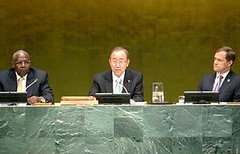 承諾將有來自公共與私人來源共超過2000億美元的資金投入2015年底的財政資源中,而這項新的承諾包括了對綠色氣候基金、減碳投資組合、轉移在碳基燃料上的投資資金,國家銀行將持續努力於投資於新的氣候行動,以及大力支持將碳排放量制定價格。
承諾將有來自公共與私人來源共超過2000億美元的資金投入2015年底的財政資源中,而這項新的承諾包括了對綠色氣候基金、減碳投資組合、轉移在碳基燃料上的投資資金,國家銀行將持續努力於投資於新的氣候行動,以及大力支持將碳排放量制定價格。
氣候高峰會於融資部份做出以下承諾:
- 由機構投資者所組成的聯盟已承諾要去除碳產生行為,1000億美元在由聯合國氣候negotatitions機構股權投資在2015年12月,並至少投資5000億美元於碳足跡的測量和披露。
- 商業銀行將在2015年年底透過發行綠色債券等創新融資工具提供300億美元於新的氣候融資上。
- 國際開發金融組織的國家雙向區域開發銀行宣布,他們已經規劃好要在2015年底前要增加的氣候(綠色)融資1000億美元(每年)在新的氣候融資活動。
- 保險業已經承諾將在2015年年底前增加一倍的綠色投資,可達到840億美元,並宣布將在2020年前增加相較於現在10倍的氣候智能型投資。發達國家和發展中國家已經開始拉同時充分利用綠色氣候基金,通過承諾數十億美元。
- 一部份已開發國家承諾將在2014至15年會把20億美元資金轉移給受到強烈關注的開發中國家以發展氣候變遷調適。
- 來自北美和歐洲的三大退休基金共同宣布他們的在跨資產類別之低碳投資的野心,且到2020年前,要使其加速超過310億美元。
- 超過70個國家和1000家公司皆認為需要制定能夠充分反映有關污染和排放的實際成本的機制,且有超過30家公司贊同「關心氣候倡議之企業領導者對於碳定價之準則」,其中包括投資決策之內部碳價是否夠高而足以對降低溫室氣體的排放產生效益。
森林
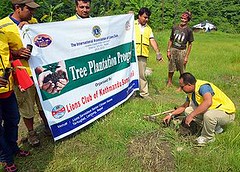 超過150合作夥伴,其中包括28個政府,8個地方政府,35家企業,16原住民團體和45個非政府組織與公民社會團體,簽署了「紐約宣言」,要求在2020年前通過減少一半森林的損失,並在十年之後的2030年將森林的損失降為零,這份聲明有承諾的背書支持,包括來自私營部門、各國政府和公民社會對於資源和行動的承諾。
超過150合作夥伴,其中包括28個政府,8個地方政府,35家企業,16原住民團體和45個非政府組織與公民社會團體,簽署了「紐約宣言」,要求在2020年前通過減少一半森林的損失,並在十年之後的2030年將森林的損失降為零,這份聲明有承諾的背書支持,包括來自私營部門、各國政府和公民社會對於資源和行動的承諾。
該宣言重申並延續承諾在造林和制止毀林上。
從地方到國家,由棕櫚油公司、食品公司、原住民、公部門、私部門,支持這個籃子是強而有力的承諾,為REDD+機制提供資金,我們所有的依賴來自於經大規模砍伐森林之程序所提供的免費供應鏈商品。
農業
以5億小農為目標推動氣候智能型農業,幫助其減少其排放量,建置因應氣候變遷影響之調適能力:
- 新的氣候智能型農業全球聯盟是由40多個政府,組織和公司共同支持。
- 參加的國家代表著數以百萬計的農民、至少有四分之一的世界穀物產量、43億人營養不足、全球農業溫室氣體排放量的16%。
- 在2025年前非洲氣候智能型農業聯盟將透過非洲智能農業幫助到大約2500萬名農夫。
- 世界500強企業,包括凱洛格公司、麥當勞、沃爾瑪,皆致力增強各自供應鏈與氣候智能型生產方式,以提高生產食品的數量。
產業
商業夥伴制定了五種能明顯減少排放措施,且特別指出需透過減少短暫類之氣候污染物 - 包括甲烷,黑碳(煤煙)和氫氟碳化物(HFCs) ,而可以有立竿見影的影響,且預計在未來35年能減緩全球氣溫高達0.6°C,同時對人的健康有所助益與增加糧食生產。
- 石油和天然氣甲烷的合作關係,使許多公司在內包括意大利的ENI、墨西哥國家石油公司、美國天然氣公司西南能源、挪威國家石油公司集團、BG集團、前英氣、泰國的石油和天然氣公司,PTT、自然資源保護委員會、美國環保協會和主要的石油和天然氣生產國像墨西哥,尼日利亞,挪威,俄羅斯聯邦和美國政府,減少最主要的溫室氣體之一:甲烷的排放。而這在產業中獨特的減排甲烷平台,提供企業、政府和民間組織一個強大且透明的合作方式。
- 石油和天然氣之氣候倡議由沙特阿美公司做為多家公司之代表,包括BG集團,埃尼,墨西哥國家石油公司、TOTAL,發表提出將建立一個平台,分享產業內的最佳做法,來解決關鍵的氣候風險,並促進有意義的行動與協調,以在氣候變遷的能源方面發展再生能源、提升能源效率,並減少天然氣燃燒和甲烷排放量等等,也將在之後持續定期報告。
- 超過25個城市承諾將在2020年以前開發與完成,關於廢棄物相關部門減少短周期之氣候污染物行動的量化計劃。在明年預計此一網絡將擴大至50個城市,並在2020以前能擴展至150個城市,且在最後使其超過1000個城市。
- 如德國郵政、DHL、IKEA、以及如歐洲綠色貨運、Eco Stars的綠色貨運,這些超過20個國家、約24個具規模的非政府組織、跨國企業、政府間組織所支持的環球領袖企業,展開了協調機制,為朝「乾淨運輸」前進,而加以調整與增加現在運費。
- 超過20個國家與10個國際組織宣佈他們開始支持並展開一項正式談判,一項根據蒙特利爾議定書下關於逐步減少氫氟碳化合物生產及消費的談判,而同時,在聯合國框架氣候變化公約下,排放核算和報告將繼續於2014年11月開始正式談判。
再生能源
向開發中國家,如非洲東部與南部、小島嶼國家提供乾淨、再生能源的兩個新舉措。
太陽能: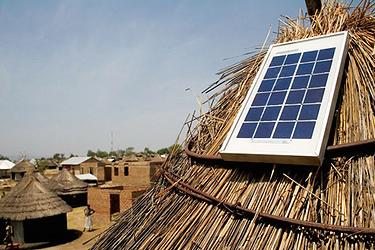 19個非洲東南部國家的部長授權了一份「非洲乾淨能源走廊」協議,將透過東非和南非電力聯盟推展再生能源發展計畫,累積減碳實力,以期在2030年之前達到每年減少310噸碳排的目標。
19個非洲東南部國家的部長授權了一份「非洲乾淨能源走廊」協議,將透過東非和南非電力聯盟推展再生能源發展計畫,累積減碳實力,以期在2030年之前達到每年減少310噸碳排的目標。
小島發展中國家燈塔協議,則是小島國家將能源結構朝向再生能源轉型時的方針。透過夥伴關係和特定的合作項目提出5年5億計畫,設立新的100百萬瓦太陽能光伏容量,以及新的風力發電廠、為數眾多的小型小風力、地熱和海洋發電設施。
能源效率
超過40名國家代表、30座城市和數十家企業共同做出一項大規模的能源效率承諾,要減少溫室氣體排放,並縮減能源支出。
車輛燃油效率。孟加拉、智利、哥斯大黎加、衣索比亞、印尼、尼泊爾、斯里蘭卡、烏拉圭、塞爾維亞和越南等10國提出堅定承諾,要在「全球燃料經濟協議」(Global Fuel Economy Initiative,GFEI)之下採取行動並推行政策。在發展燃料經濟政策方面,GFEI正與30多國合作,目的要在2030年前增長新車的能源效率一倍,所有汽車則須在2050年之前也達到這個標準。這也意味著在2025年之前,1年可減少10億噸的二氧化碳排放,2050年之前每年便可減少20億噸。
綠建築
燈光節約。在聯合國環境署和全球環境基金(GEF)發起「啟明倡議」下,已有55國承諾在2016年之前淘汰耗能的白熾燈泡,現在又有超過10個亞太地區的國家成為合作夥伴,致力於改善住宅照明的能源效率。他們每年將共同省下2兆瓦時的電力消耗,減少440千噸的二氧化碳排放與2億7千萬的電費支出。
為改善大型家電的能源效率標準,已有28個國家展現合作意願,成立一個新的家電節能全球夥伴關係。光是這些國家的節能冷氣機、電冰箱和電風扇,每年就可以減少165兆瓦時的電力消耗,減少5千4百萬的噸的溫室氣體排放,省下的電力支出每年達2百億之多。
建築節能的推展無疑是個新的開始,從城市到州縣,地方政府到中央政府,無不加速推行相關政策,推廣節能建築。目前展開合作計畫的中央和縣市級政府包括了丹麥的哥本哈根、秘魯的利馬、墨西哥城、美國威斯康辛州的密爾瓦基市,以及日本的富山縣;表態支持的企業則有江森自控(Johnson Controls)、Velux、飛利浦(Philips)和聯合技術公司(United Technologies)。
城市、中央或地方政府建築的擴張或裝修,可以依靠區域能源系統。這些系統通常會使用工廠回收的餘熱,並結合了升溫和冷卻的功能,在一群建築物中傳送。
加入這項協議的城市有:鞍山市(中國遼寧省)、貝廷(巴西)、波哥大(哥倫比亞)、福克沙尼(羅馬尼亞)、赫爾辛基(芬蘭)、基多(厄瓜多)、勒西菲(巴西)、聖荷西(哥斯大黎加)、卡利(哥倫比亞)、首爾(南韓)、索羅卡巴(巴西)、聖保羅(美國)、溫哥華(加拿大)和韋克舍(瑞典)。這19個城市的所做的改變,每年可以減少5百萬噸的二氧化碳排放。一同加入協議的夥伴企業則有:丹佛斯(Danfoss)、葛蘭富(Grundfos)、西門子(Siemens)、Vattenfall、威立雅(Veolia)、Climespace和Empower。
調適能力
各種創新與應變的合作共識也在氣候高峰會上誕生,其中有多項與國家和社群面對氣候變遷的第一線防禦有關。
- 使用者友善的倡議,為世界各國提供「超實用」的氣候變遷資訊。
- 由非洲聯盟運作的財務實體「非洲投資風險(The African Risk Capacity,ARC)」是一項將極端氣候災難風險最低化的創新財務工具,宣布擴展業務項目和範圍,將巨災債券也納入其中。這項倡議旨在將氣候風險從政府,以及政府保障的農夫、牧民身上轉移至ARC,便更能承擔這些風險。
- 為回應越來越頻繁的極端氣候災難,一項將氣候風險融合進財務系統的倡議也應運而生。由投資人、信用評等機構、承保人和金管單位共同宣布,這項倡議旨在為銀行、證券交易和公私部門的會計作業,發展出一套氣候風險的壓力測試。
交通運輸
全球四大交通聯盟將大幅提升經認證的低碳運輸技術,包括提升電動車的數量、鐵路和空中運輸的效率,以及在全球推行永續公共運輸等倡議。
- 一項新的都市電動車協議(Urban Electric Mobility Initiative)表示,將在2030年之前,每年增加30%的電動車銷售量。
- 自行車:公共交通國際聯會(International Association of Public Transport,UITP)的氣候領導小組透過一連串的規範,從增加新公車和捷運線的數量,到介紹德、日等國的車輛和自行車,讓39個國家共110間公共運輸公司達到減少溫室氣體排放的目的。
- 國際鐵路聯盟(The International Union of Railways,UIC)在全世界有240個會員國,包括以鐵路為主的歐洲、亞洲、俄羅斯、印度和美國,提出一項低碳永續鐵路運輸挑戰,也就是增加貨運和交通的鐵路使用率,並在2030年達到效率改善與減碳幅度各提升50%;2050年分別達到效率改善60%,減碳幅度75%的目標。這項協議將讓鐵路運輸的二氧化碳排放量在2050年之前降低75%。
- 國際民用航空組織(The International Civil Aviation Organization,ICAO)與民航業則是加碼承諾,藉由跨產業的合作,以2005為基準,在2050年前達到二氧化碳淨排放減半,而這也是該全球產業所設立的長期目標。自去年9月高峰會以來,該產業的龍頭和合作夥伴,例如維珍航空和泰航等都已展開達標行動。
更進一步的大膽承諾還包括,已有超過160家機構及地方政府與超過500位的民眾承諾表示,未來3至5年內將不再投資石化燃料產業,撤資總金額達5百億,並轉投資再生能源領域。
New actions to immediately tackle climate change were announced today by government, business, finance and civil society leaders at the UN Secretary-General’s Climate Summit in New York.
The new initiatives for finance, farming, forests, as well as new coalitions bringing together cities, businesses and citizens will cut emissions and strengthen resilience to the impacts of climate change and global warming.
“Change is in the air. Today’s Climate Summit has shown an entirely new, cooperative global approach to climate change,” Ban said. “The actions announced today by governments, businesses, finance and civil society show that many partners are eager to confront the challenges of climate change together.”
The initiatives announced at United Nations headquarters in New York range from actions that will have a profound impact on global financial markets to more local actions that will reduce the emissions of smallholder farmers.
In the energy sector, two initiatives announced today will be scaled up to expand access to clean, renewable energy for people in eastern and southern Africa and the Small Island Developing States.
“Today shows that the world is finally waking up to the economic and social opportunities of taking action on climate change,” Ban said. “The Climate Summit is showcasing a level of ambition not seen before and producing actions and new initiatives that will make a significant difference.”
Key announcements made today:
Finance: An initiative to mobilize more than US$200 billion in financial resources from public and private sources by the end of 2015. This includes new pledges for the Green Climate Fund, the decarbonization of investment portfolios, moving assets out of fossil fuel-based investments, the continued efforts of national banks to invest in new climate activities, and wide support for putting a price on carbon emissions.
The Summit announcements for climate financing include the following commitments:
* - A coalition of institutional investors has committed to decarbonizing $100 billion in institutional equity investments by the UN climate negotatitions in December 2015, and to measure and disclose the carbon footprint of at least $500 billion in investments.
* - Commercial banks will provide $30 billion in new climate finance by the end of 2015 by issuing green bonds and other innovative financing instruments.
* - The national, bilateral and regional development banks of the International Development Finance Club announced they are on track to increase their direct green/climate financing to $100 billion-a-year for new climate finance activities by the end of 2015.
* - The insurance industry has committed to double its green investments to $84 billion by the end of 2015 and announced that it would increase the amount placed in climate-smart investments to ten times the current amount by 2020. Developed and developing countries have started pulling together to capitalize the Green Climate Fund, by pledging several billion dollars.
* - A group of developed countries announced a commitment of $2 billion to be channeled to the developing countries during 2014-2015 with strong focus on adaptation.
* - Three major pension funds from North America and Europe announced their ambition to accelerate their investments in low-carbon investments across asset classes up to more than $31 billion by 2020.
* - More than 70 countries and 1,000 companies endorsed the need for developing mechanisms that would adequately reflect the true costs relating to polluting and emissions; and over 30 leading companies endorsed the Caring for Climate Business Leadership Criteria on Carbon Pricing, which include setting an internal carbon price high enough to materially affect investment decisions to drive down greenhouse gas emissions.
Forests: More than 150 partners, including 28 government, eight subnational governments, 35 companies, 16 indigenous peoples groups, and 45 NGO and civil society groups, are signing the New York Declaration on Forests which calls for cutting the loss of forests in half by 2020 and ending it a decade later in 2030. The declaration is backed by commitments, including pledges of resources and actions from the private sector, governments and civil society.
The Declaration reaffirms and stretches commitments to reforestation and halting deforestation.
Supporting this are a basket of strong commitments by the private sector, including palm oil companies and food companies, Indigenous Peoples and governments – from local through national – to financial support for REDD+, deforestation programs at scale, and deforestation-free supply chains for commodities on which we all rely.
Over 20 global food companies committed to deforestation-free sourcing policies of palm oil. Three of these – the world’s largest palm oil companies, Wilmar, Golden Agri-Resources and Cargill – committed additionally to work together in Indonesia on implementation with governments and Indigenous Peoples.
Taken together, the share of palm oil under zero deforestation commitments has grown from zero to about 60 percent in the last year, with potential to reduce 400-450 million tons of CO2 per year by 2020, or two billion tons in the period through 2020.
Agriculture: Initiatives to promote Climate-Smart Agriculture were announced with the goal of helping 500 million smallholder farmers reduce their emissions and build resilience to the impacts of climate change:
* - A newly launched Global Alliance for Climate-Smart Agriculture was supported by more than 40 governments, organizations and companies.
Countries joining represent millions of farmers, at least a quarter of the world cereal production, 43 million undernourished people and 16 percent of total agricultural greenhouse gas emissions.
* - An Africa Climate-Smart Agriculture Alliance will help some 25 million farming households across Africa practice climate-smart agriculture by 2025.
* - Fortune 500 companies, including Kellogg Company, McDonalds and Walmart, committed to increase the amount of food in their respective supply chains produced with climate-smart approaches.
Industry: Five significant initiatives to address emissions reductions were made by business partners, with special emphasis to reduce potent short-lived climate pollutants – including methane, black carbon (soot), and hydrofluorocarbons (HFCs) – that can have immediate impact and slow the increase in global temperatures expected over the next 35 years by as much as 0.6°C while benefiting people’s health and the production of food.
* - The Oil & Gas Methane Partnership was launched, bringing companies, including ENI of Italy, Pemex; the U.S. gas company Southwestern Energy; Norway’s Statoil Group; BG Group, the former British Gas, and Thailand’s oil and gas company, PTT, together with the Natural Resources Defense Council and Environmental Defense Fund and governments from major oil and gas producing countries, including Mexico, Nigeria, Norway, the Russian Federation and the United States, to reduce methane emissions, one of the most potent greenhouse gases. This unique platform to reduce methane emissions in the industry provides a robust transparent and collaborative approach for businesses, governments and CSOs to work together.
* - The Oil and Gas Climate Initiative also announced by Saudi Aramco on behalf of others engaged, including BG Group, Eni, PEMEX and TOTAL aims to build a platform to share best practices within the industry, address key climate risks, and catalyze meaningful action and coordination on climate change in areas such as energy access, renewable energy, energy efficiency, reduction of gas flaring and methane emissions, among others – followed by regular reporting on ongoing efforts.
* - More than 25 cities committed to develop and carry out quantifiable plans of action to reduce short-lived climate pollutants from the waste sector by 2020. The network is anticipated to expand to 50 cities by next year with the goal of 150 cities by 2020, and eventually to include 1,000 cities.
* - Global corporate leaders such as Deutsche Post, DHL and IKEA, and green freight programs, such as Green Freight Europe and Eco Stars, launched a coordinating mechanism – the Global Green Freight Action Plan – to support more than 20 countries and about two dozen leading NGOs, multinational and intergovernmental organizations that aim to align and enhance existing efforts toward cleaner freight delivery.
* - More than 20 countries and 10 international organizations announced their support to begin formal negotiations of an amendment to phase down the production and consumption of HFCs under the Montreal Protocol, while emissions accounting and reporting would remain under the United Nations Framework Convention on Climate Change – stressing the need to begin formal negotiations in November 2014.
Renewable Energy: Two new initiatives aimed at providing clean, renewable energy to developing countries in Eastern and Southern Africa and in Small Island Developing States.
* - Ministers from 19 eastern and southern African countries endorsed the Africa Clean Energy Corridor initiative, which will advance the development of renewable energy projects and has potential to cut annual carbon dioxide emission levels by 2030 by 310 metric tonnes throughout the Eastern and Southern Africa Power Pools. Cooperation on renewable energy deployment in the region would reduce generation costs by 4 percent and nearly triple electricity supply, transforming the current energy mix of a large portion of the African continent.
* - The Small Island Developing States Lighthouse initiative, a framework for action to support the island countries as they transform their energy systems to include a greater share of renewable energy, was launched. Through partnerships and focused cooperation, the initiative aims to mobilize $500 million within five years and deploy 100 megawatts of new solar photovoltaic capacity, consisting of new wind power, significant quantities of small hydropower and geothermal energy, and marine technology.
Energy Efficiency: Leaders from more than 40 countries, 30 cities and dozens of corporations launched large-scale commitments on energy efficiency to cut emissions of greenhouse gases and reduce energy costs.
* - Vehicle Fuel Efficiency. Ten countries – Bangladesh, Chile, Costa Rica, Ethiopia, Indonesia, Nepal, Serbia, Sri Lanka, Uruguay and Vietnam – are making firmer commitments to adopt and implement policies under the Global Fuel Economy Initiative. Thirty more countries are working with GFEI at various stages of developing fuel economy policies. The goal of GFEI is to double the efficiency of all new vehicles by 2030 and all vehicles by 2050. This would save more than 1 gigatonnes of CO2 a year by 2025 and more than 2 gigatonnes annually by 2050.

The energy-efficient Bullitt Center building in downtown Seattle, Washington is roofed with solar panels. (Photo by Brad Kahn)
* - Lighting Efficiency. More than 10 countries in Asia and the Pacific are joining the 55 countries already committed to phasing out inefficient incandescent lamps by 2016, as part of the UNEP/GEF en.lighten partnership to improve efficiency of residential lighting. They will collectively save more than 2 terawatt hours in electricity consumption yearly, reducing by 440 kilotonnes their emissions of CO2 and lowering their electricity bills by more than $270 million each year.
* - Twenty-eight countries have expressed their willingness to join a new Global Partnership on Appliances and Equipment, which seeks to improve energy performance standards for large appliances. The use of high-efficiency air conditioners, refrigerators and fans alone in these countries will reduce electricity consumption by 165 TWh per year, avoiding emission of 54 million tonnes of GHGs annually, and saving more than $22 billion in electricity bills each year.
* - Building Efficiency is a new initiative being launched to help city, state, regional and national governments speed up adoption of policies that promote energy-efficient buildings. National and municipal governments launching the partnership include Copenhagen (Denmark), Lima (Peru), Mexico City (Mexico), Milwaukee (USA) and Toyama (Japan). Among the business partners supporting the process are Johnson Controls, Velux, Philips and United Technologies.
* - District Energy Systems aims to support cities or regional and national governments develop, retrofit or scale up district energy systems. These systems consolidate the provision of heating and cooling to a group of buildings, often using waste heat from an industrial facility.
Cities joining this initiative include: Anshan (Liaoning Province, China), Betim (Brazil), Bogotá (Colombia), Focsani (Romania), Helsinki (Finland), Jinan (Shandong Province, China), London (UK), Milano (Italy), Nairobi (Kenya), Paris (France), Quito (Ecuador), Recife (Brazil), San Jose (Costa Rica), Santiago de Cali (Colombia), Seoul (Republic of Korea), Sorocaba (Brazil), St. Paul (USA), Vancouver (Canada) and Vaxjo (Sweden). Action by these 19 cities could avoid more than five megatonnes of CO2 emissions annually.
Private sector partners include: Danfoss, Grundfos, Siemens, Vattenfall, Veolia, Climespace and Empower.
Resilience: A variety of innovative resilience initiatives were announced at the Summit, including many that will strengthen countries and communities on the climate front lines. These include:
* - An initiative to provide user-friendly “news you can use” climate information for countries around the world.
* - The African Risk Capacity, an innovative financial tool for mitigating risks from extreme weather events, announced an expansion of its services and coverage, including the introduction of Catastrophe Bonds. The initiative aims to transfer the burden of climate risk away from governments – and the farmers and pastoralists whom they protect – to the ARC, an African-owned, African Union-led financial entity that can better handle these risks.
* - An initiative to integrate climate risk into the financial system was launched in response to the expanding number of extreme weather events. Investors, credit ratings agencies, insurers and financial regulators unveiled the initiative to develop climate risk stress testing for banking and securities regulation, as well as public and private sector accounting practices.
Transport: Four global transport alliances will significantly scale up proven low-carbon transport technologies, including initiatives to increase the number of electric vehicles on the road, increase the efficiency of rail transport and air travel, and provide sustainable public transportation options around the world.
* - A new Urban Electric Mobility Initiative will increase the number of electric vehicles in cities to least 30 percent of all new vehicles sold annually by 2030.

Bikes to share in Washington, DC (Photo by Teresa Grau Ros)
* - The International Association of Public Transport Declaration on Climate Leadership resulted in over 350 commitments and actions from 110 public transport entities in 39 countries to reduce greenhouse gas emissions through a host of measures, from increasing the number of new bus and metro lines to introducing car and bike sharing in countries around the globe – from Germany to Japan and from Colombia to Lebanon.
* - The International Union of Railways (UIC) – with 240 members worldwide, including the major railways of Europe, China, Russia, India and the United States – launched the Low-Carbon Sustainable Rail Transport Challenge. It aims to increase rail use for freight and transport and meet ambitious targets for increased efficiency and emission reduction of 50 percent each by 2030 and 60 and 75 percent, respectively, by 2050. This initiative could result in 75 percent reduction of carbon dioxide emissions from rail transport by 2050.
* - The International Civil Aviation Organization (ICAO) and the aviation industry, represented through the cross-industry Air Transport Action Group (ATAG), stepped up commitments to achieve the industry’s long-term existing global goal to halve net CO2 emissions by 2050 compared to 2005 levels, including to implement a global market-based measure for international aviation for implementation from 2020 onward. Over 100 actions by partners and industry leaders – including Virgin Atlantic and Thai Airways – have been launched or scaled up since the Secretary-General’s call to action for the Summit in Sept 2013.
New coalitions across these areas and more stepped forward with bold announcements, including more than 160 institutions and local governments and more than 500 individuals committed to divesting $50 billion from fossil fuel investments within the next 3-5 years and to reinvest in new energy sources.
A full list of the announcements and commitments made at the Climate Summit can be found atwww.un.org/climatechange/summit
※ 全文及圖片詳見:ENS

